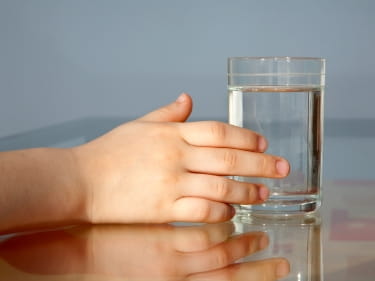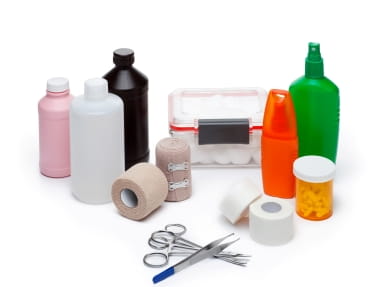No, You Can’t Drink Rubbing Alcohol

The Bottom Line
Rubbing alcohol is a widely available household product often used to disinfect wounds. It is most commonly 70% isopropyl alcohol. It can be toxic if swallowed, inhaled, or absorbed through the skin. It is flammable and should always be kept away from open flames.

What is rubbing alcohol?
Rubbing alcohol is the term for a variety of alcohol-containing products primarily intended for use on the skin. The most common form of rubbing alcohol is 70% isopropyl alcohol (also known as isopropanol). The remaining 30% is water. It is colorless and smells strongly of alcohol. It is used as a disinfectant and is the active ingredient in alcohol swabs, such as those used to clean skin before an injection. Higher concentrations of isopropyl alcohol are less effective as disinfectants and are more irritating.
You can buy rubbing alcohol at any pharmacy or grocery store. It is effective for killing bacteria and is often the go-to solution for cleaning minor cuts and scrapes. Rubbing alcohol can also be used to clean and disinfect small household items including thermometers, computer keyboards, and phones.
Can you drink rubbing alcohol?
No. Rubbing alcohol is for external use only. The term “rubbing” was added to emphasize external use and to better distinguish it from alcohol intended for drinking.
Is rubbing alcohol poisonous?
Poison Control often receives calls about children who have swallowed rubbing alcohol. Because it has a strong, unpleasant taste, children usually don't drink much. In general, swallowing a sip of rubbing alcohol leads to few symptoms.
Someone who has intentionally swallowed rubbing alcohol can become drunk. Symptoms might include sedation, slurred speech, unsteadiness, and vomiting. Isopropyl alcohol is extremely irritating to the digestive tract, where it can cause vomiting, diarrhea, pain, and bleeding in the stomach and intestines. This can lead to dehydration, low blood pressure, shock, and coma.
Is rubbing alcohol safe for the skin?
When used in small amounts on the skin, rubbing alcohol is safe, although minor irritation and dryness are possible. However, people have been known to use towels or blankets soaked with rubbing alcohol on the skin to reduce fever. This does not reduce fever and can easily lead to rubbing alcohol poisoning. For many years, it was thought that toxicity in these cases resulted from inhaling rubbing alcohol fumes. While this does indeed occur, recent evidence shows that rubbing alcohol can also be absorbed through the skin.
Is rubbing alcohol flammable?
Despite being 30% water, rubbing alcohol will burn if ignited and can reach temperatures above 1000 F. Rubbing alcohol should only be used in well-ventilated areas far from open flames. Many social media posts have described a “rubbing alcohol challenge” in which people soak themselves with rubbing alcohol and then light it. This is extremely dangerous and has resulted in serious, permanent burn injuries.
What should I do if someone has swallowed rubbing alcohol?
If you believe someone has swallowed rubbing alcohol, use the webPOISONCONTROL online tool to get help, or call Poison Control at 1-800-222-1222. Do not try to make the person throw up, and do not wait to see what happens.
Serkalem Mekonnen, RN, BSN, MPH
Certified Specialist in Poison Information
Revised February, 2024 by William G. Troutman, PharmD
Professor of Pharmacy Emeritus
Poison Control Media Information
Did you find this page helpful? If so, we need your support. Poison Control is in constant competition with misinformation online. Links to www.poison.org or our webPOISONCONTROL triage tool from other websites and blogs help internet searchers quickly find accurate information and Poison Control’s contact information in an emergency. If you use the content from this page, please provide attribution via a link back to this page, www.poison.org, or https://triage.webpoisoncontrol.org/#!/exclusions. By doing so, you could save a life. Thank you!
Poisoned?
Call 1-800-222-1222 or
Prevention Tips
- Always keep rubbing alcohol stored up and out of reach of children.
- Never transfer it from its original bottle to another container.
- Always use rubbing alcohol in a well-ventilated area.
- Never swallow rubbing alcohol to get drunk. It is not the same as ethanol. Drinking it can cause dangerous poisoning.
This Really Happened
A 2-year-old boy was brought to an emergency room (ER) because of drowsiness, fever, decreased appetite, and respiratory congestion. In the ER, he was limp, had no cry, and vomited material that looked like coffee grounds, which indicated bleeding in his stomach. The boy’s grandmother had tried to “sweat out” his fever by soaking him with about 4 oz. of rubbing alcohol (70% isopropyl alcohol) and wrapping him in a tight blanket for several hours just before he was brought to the ER. The family said that no rubbing had been swallowed. A laboratory test found a substantial concentration of isopropyl alcohol in his blood. After 12 hours of supportive treatment in the pediatric intensive care unit, the boy was much improved. He was well enough to go home the next day. The family was educated about proper fever treatment (from Dyer et al., 2002).For More Information
Fire officials warn of dangerous ‘rubbing alcohol challenge’ | CBS
Isopropanol alcohol poisoning | Medline Plus
What to Know About Rubbing Alcohol | WebMD
The difference between isopropyl alcohol vs. rubbing alcohol | Medical News Today
References
Dyer S, Mycyk MB, Ahrens WR, Zell-Kanter M. Hemorrhagic gastritis from topical isopropanol exposure. Ann Pharmacother. 2002;36(11):1733-1735.
Gallagher N, Edwards FJ. The diagnosis and management of toxic alcohol poisoning in the emergency department: a review article. Adv J Emerg Med. 2019;3(3):e28.
Ross JA, Borek HA, Holstege CP, King JD. Toxic alcohol poisoning. Emerg Med Clin North Am. 2022;40(2):327-341.
Slaughter RJ, Mason RW, Beasley DM, Vale JA, Schep LJ. Isopropanol poisoning. Clin Toxicol (Phila). 2014;52(5):470-478.
Poisoned?
Call 1-800-222-1222 or
Prevention Tips
- Always keep rubbing alcohol stored up and out of reach of children.
- Never transfer it from its original bottle to another container.
- Always use rubbing alcohol in a well-ventilated area.
- Never swallow rubbing alcohol to get drunk. It is not the same as ethanol. Drinking it can cause dangerous poisoning.
